Bigfoot’s Killer-N 1102 Wireless Networking vs. the World
by Jarred Walton on August 10, 2011 10:38 AM ESTNetgear 2.4GHz Obstructed Performance
Our next test is the same router as before, only now we’ve moved the laptops to the opposite side of the house. For this test, the router is still upstairs, but the laptops are about 50 feet away (direct line) with several walls and a floor in between. As you might expect, performance is lower on every laptop in every test, though some controllers hold up better than others.
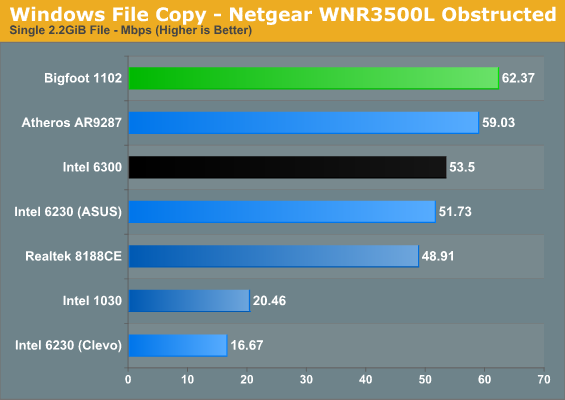
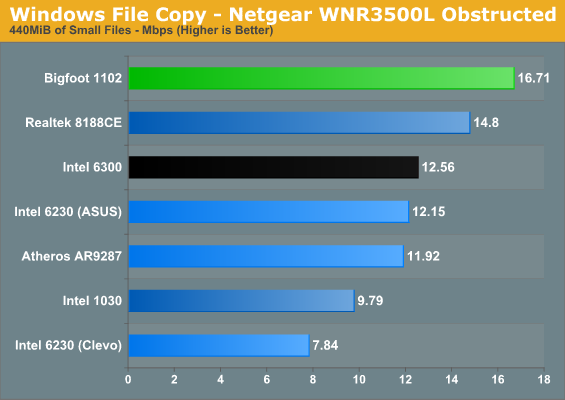
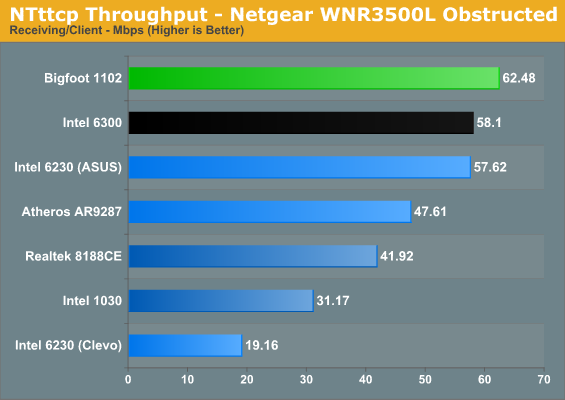
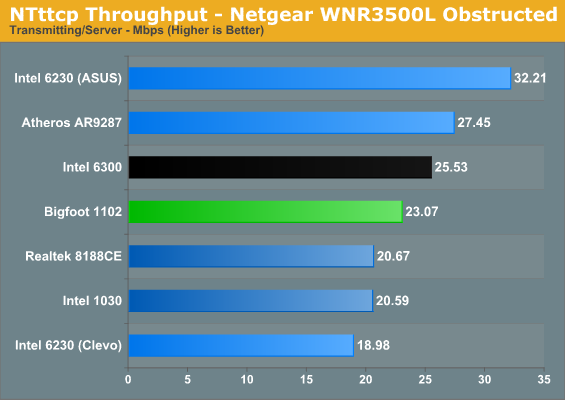
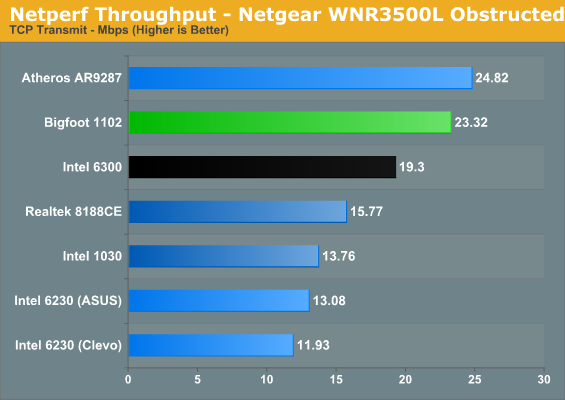
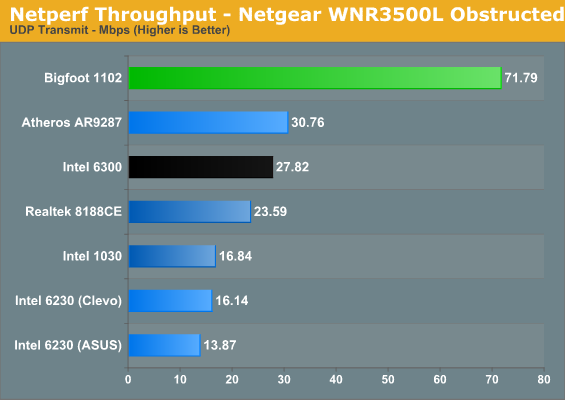
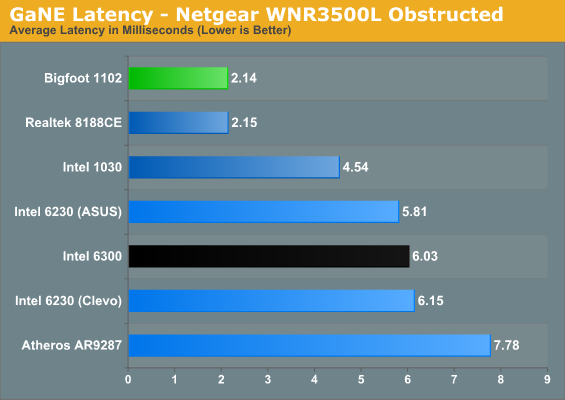
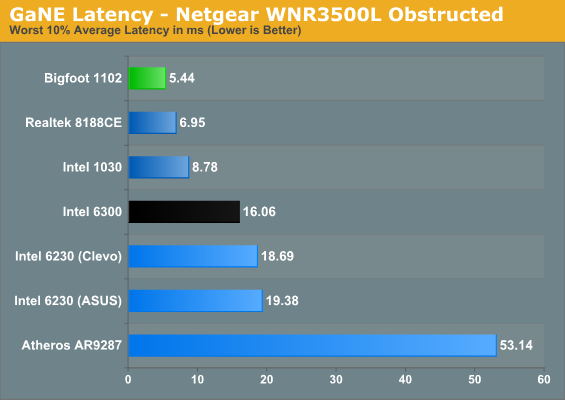
The Bigfoot 1102 leads in most of the tests, with the Realtek and Atheros generally claiming second and third. Once again, the ASUS K53E performs better than the Clevo sample unit in this test—much better in fact—despite both using the same Intel Advanced-N 6230 chipset. Also note that all of the cards do quite a bit better at receiving data than at transmitting (see the NTttcp charts), which makes sense as most laptops don’t put a ton of power into their transmit radios. It’s interesting that in our obstructed tests, the Intel 6230 (in the K53E) and 6300 along with the Atheros AR9287 all manage higher transmit rates than the BF 1102 with NTttcp, though that advantage doesn’t translate over to Netperf.
The Bigfoot 1102 still maintains a decisive lead in the latency tests, with the Realtek 8188CE nipping at its heels. Oddly enough, latency is actually lower on a couple of the cards (the K53E with Intel 6230 specifically), but that’s probably in part because the connection rate is no longer as high. Most of the laptops connected at less than 130Mbps, with a lot of variance in the speed as the cards frequently renegotiate their connections. Bigfoot also continues to dominate the copy time for lots of small files, again illustrating that their “secret low latency sauce” helps in areas other than gaming. The single stream Realtek chipset comes in second in that test, and it has the second lowest latency of the tested controllers.
The takeaway here is that even the best network cards won’t perform all that well without a clear signal. If you have a large house or office and you want to provide good coverage, setting up multiple access points would be necessary to obtain optimal performance for every room. We’ll look at how far the laptops can get from the router before experiencing connection problems later, but in most houses the Bigfoot 1102 should get a good signal.










52 Comments
View All Comments
neothe0ne - Sunday, August 14, 2011 - link
"And Dell, Asus, Acer, and Sony all do the same thing."Are you sure about that? I was under the impression HP and Lenovo were alone in the industry with the WLAN whitelist. And anyway, Dell does offer the Intel Centrino 6230 on the XPS 15 now, unlike HP's dv6 which is stuck in budget-tier Intel WiFi Link 1000 land.
cjl - Tuesday, August 16, 2011 - link
Dell, at least in their Alienware products, definitely does not whitelist. After reading this article, I got one of the Killer 1102 cards for my M11xR2 (which comes with a rather terrible card by default, and there were no upgrade options offered), and it works just fine. I popped it in, installed the drivers, and everything has been working great since.Musafir_86 - Thursday, August 11, 2011 - link
Hello,-Thanks for the article, but did you tested those adapters with or without any security/encryption/password protection scheme? I mean WEP or WPA/WPA2 - I think encryption put some overhead in the throughput.
Thanks.
JarredWalton - Thursday, August 11, 2011 - link
All testing was done with WPA2 AES. Most modern cards do fine with that, though a few years back it was sometimes slower IIRC.Musafir_86 - Thursday, August 11, 2011 - link
-Okay, thanks for the clarification. :)Yummer72 - Thursday, August 11, 2011 - link
Thanks for the informative review.I wonder if Bigfoot will continue to have an advantage if the "WLAN Optimizer" program was used with the other WiFi cards?
http://www.martin-majowski.de/wlanoptimizer/
I have personally seen significantly improved performance and the elimination of "lag spikes" (QuakeLive) with this software tweak.
Any comments?
JarredWalton - Thursday, August 11, 2011 - link
I'll give that a try; it could very well remove the spikes, leaving the primary advantage as the lower base latency.bhima - Thursday, August 11, 2011 - link
You should review that 95% color gamut matte screen in that Mythlogic ;)loopingz - Thursday, August 11, 2011 - link
First of all thanks for highlighting that I can change my wifi adaptator on my laptop. Mine is always frozing during transfert in windows (linux is fine).Second thanks for helping me choosing the good one.
I hesitate now between intel 6300 for range, correct performance and price, and the 110 2/3 for pure performance.
May be best of two worlds intel 6300 in the eeepc that travel a lot and bigfoot in the main home laptop.
Can I recycle a my old wifi card or a new one using an antenna and puting it in my desktop computer?
I will give try to Wlanoptimizer too because watching movie from the raid5 nas still not perfect (router linksys e3k).
Thanks for the good job.
name99 - Thursday, August 11, 2011 - link
"Wireless networking also tends to need more overhead for error checking and interference losses, and there’s a question of whether the streams are linearly independent enough to get higher throughput, orientation, directionality of signal, etc. Even though you might connect at 450Mbps or 300Mbps, you’ll never actually reach anywhere near that level of throughput. In our testing, the highest throughput we ever saw was around 75% utilization of the available bandwidth, and that was on a 300Mbps connection."This is not a useful description of the situation. The nominal speed of a connection (ie the MCS index) already includes error correction overhead --- that's why you see a range of bit-rates, with the same parameters (modulation, number of streams, bandwidth) --- these different bit-rates correspond to different levels of error correction, from the strongest (1/2 coding rate) to the weakest (5/6).
It is also unlikely that corrupt packets and the retransmission (what you are calling "interference losses", though in your environment noise is likely more relevant than interference) are substantial --- both ends aggressively modify the MCS index to get the best throughput, and try to keep the number of corrupt packets low.
The real issue is the MAC --- the negotiations over who next gets airtime. This used to be a big deal with wired ethernet as well, of course, but it went away with switches around the time we all moved to 100TX. The basic 802.11n MAC does not rely on any real co-ordination, just on timing windows and retries, and it wastes a phenomenal amount of time. 802.11e improves the situation somewhat (I expect all the systems that get 75% efficiency are using 802.11e, otherwise they'd see around 50% efficiency), but it's still not perfect.
What one really wants is a central arbiter (like in a cell system) that hands out time slots, with very specific rules about who can talk when. For reasons I don't understand, 802.11 has been very resistant to adding such a MAC protocol (802.11e has elements of this, but does not go full-hog), but I would not be surprised if we finally see such as part of the 802.11n successor --- it's just such an obvious place to pick up some improvement. The real problem is that to do it right you have to give up backward compatibility, and no-one wants to do that. At least if we'd had it in 802.11n, then we'd be part way to a better world (people could switch it on once all their g equipment died, eg at home).